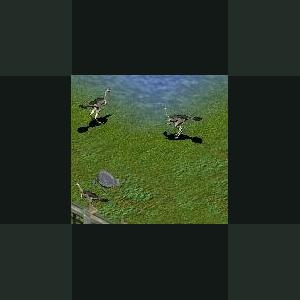About This File
Protoavis is claimed to have been a 35 cm tall bird that lived in what is now Texas, USA,
between 225 and 210 million years ago. Though it existed far earlier than Archaeopteryx,
its skeletal structure is allegedly more bird-like. Protoavis has been reconstructed as
a carnivorous bird that had teeth on the tip of its jaws and eyes located at the front of
the skull, suggesting a nocturnal or crepuscular lifestyle. The fossil bones are too bad
ly preserved to allow an estimate of flying ability; although reconstructions usually
show feathers (see link below), judging from thorough study of the fossil material there
is no indication that these were present (Paul, 2002; Witmer, 2002).
However, this description of Protoavis assumes that Protoavis actually existed and,
if so, that it has been reconstructed correctly. Almost all paleontologists doubt that
Protoavis is a bird, or even a good species, because of the circumstances of its
discovery, and unconvincing avian synapomorphies in its fragmentary material.
When they were found at a Dockum Formation quarry in the Texas panhandle in 1984,
in a sedimentary strata of a Triassic river delta, the fossils were a jumbled cache of
disarticulated dinosaur and other bones that may reflect an incident of mass mortality
following a flash flood.
The discoverer, Sankar Chatterjee of Texas Tech University, was convinced that some of
these crushed bones belonged to two individuals - one old, one young - of the same
species. However, only a few parts were found, primarily a skull and some limb bones
which moreover do not well agree in their proportions respective to each other, and this
has led many to believe that the Protoavis fossil is chimeric, made up of more than one
organism: the pieces of skull appear like those of a coelurosaur, while most parts of
the limb skeleton suggest affinities to ceratosaurs and at least some vertebrae are most
similar to those of Megalancosaurus[2], which despite what its name may suggest is not a
dinosaur but rather an avicephalan diapsid:
"Everywhere one turns; the very fossils ascribed thereto challenge the validity of
Protoavis. The most parsimonious conclusion to be inferred from these data is that
Chatterjee's contentious find is nothing more than a chimera, a morass of long-dead
archosaurs."
If it really existed, Protoavis would raise interesting questions about when birds
began to diverge from the dinosaurs, but until better evidence is produced, the
animal's status currently remains uncertain. Furthermore, paleobiogeography suggests
that birds did not colonize the Americas until the Cretaceous; the most primitive
lineages of unequivocal birds found to date are all Eurasian. Certainly, the fossils
are most parsimoniously attributed to primitive dinosaurian and other reptiles as
outlined above. However, coelurosaurs and ceratosaurs are in any case not too distantly
related to the ancestors of birds and in some aspects of the skeleton not unlike them,
explaining how their fossils could be mistaken as avian; Archaeopteryx itself was
initially believed to be a small theropod dinosaur. Zhonghe Zhou sums up the matter:
"[Protoavis] has neither been widely accepted nor seriously considered as a Triassic
bird [... Witmer], who has examined the material and is one of the few workers to
have seriously considered Chatterjee’s proposal, argued that the avian status of
P. texensis is probably not as clear as generally portrayed by Chatterjee, and
further recommended minimization of the role that Protoavis plays in the discussion
of avian ancestry."
Sometimes it is claimed that Protoavis is a refutation of the hypothesis that birds
evolved from dinosaurs. But this is not true; the only consequence would be to push
back the point of divergence further back in time and possibly cause the dromaeosaurs to
be included in the bird clade. Note that at the time when these claims were originally
made, the affiliation of birds and maniraptoran theropods which today is well-supported
and generally accepted by most ornithologists was much more contentious; most Mesozoic
birds have only been discovered since then. Note also that Chatterjee himself has used
Protoavis to support a close relationship between dinosaurs and birds.
"As there remains no compelling data to support the avian status of Protoavis or
taxonomic validity thereof, it seems mystifying that the matter should be so contentious.
The author very much agrees with Chiappe in arguing that at present, Protoavis is i
rrelevant to the phylogenetic reconstruction of Aves. While further material from the
Dockum beds may vindicate this peculiar archosaur, for the time being, the case for
Protoavis is non-existent



Recommended Comments
There are no comments to display.
Create an account or sign in to comment
You need to be a member in order to leave a comment
Create an account
Sign up for a new account in our community. It's easy!
Register a new accountSign in
Already have an account? Sign in here.
Sign In Now